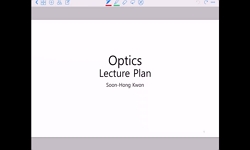The use of beamforming is effective for users in limited power environments. However, when it is applied to the downlink of a cellular system with universal frequency reuse, users near the sector boundary may experience significant interference from m...
http://chineseinput.net/에서 pinyin(병음)방식으로 중국어를 변환할 수 있습니다.
변환된 중국어를 복사하여 사용하시면 됩니다.
- 中文 을 입력하시려면 zhongwen을 입력하시고 space를누르시면됩니다.
- 北京 을 입력하시려면 beijing을 입력하시고 space를 누르시면 됩니다.
https://www.riss.kr/link?id=A104254171
-
저자
J.-H. Yeom (서울대학교) ; 이용환 (서울대학교)
- 발행기관
- 학술지명
- 권호사항
-
발행연도
2008
-
작성언어
English
- 주제어
-
등재정보
KCI등재,SCIE,SCOPUS
-
자료형태
학술저널
-
수록면
118-126(9쪽)
-
KCI 피인용횟수
0
- 제공처
-
0
상세조회 -
0
다운로드
부가정보
다국어 초록 (Multilingual Abstract)
The use of beamforming is effective for users in limited power environments. However, when it is applied to the downlink of a cellular system with universal frequency reuse, users near the sector boundary may experience significant interference from more than one sector. The use of a minimum mean square error (MMSE)-type receiver may not sufficiently cancel out the interference unless a sufficient number of receive antennas are used. In this paper, we consider the use of inter-sector beamforming that cooperates with a neighboring sector in the same cell to mitigate this interference problem in time-division duplex (TDD) environments.
The proposed scheme can avoid interference from an adjacent sector in the same cell, while enhancing the transmit array gain by using the TDD reciprocity. The performance of the proposed scheme is analyzed in terms of the output signal-to-interference-plus-noise power ratio (SINR) and the output capacity when applied to an MMSE-type receiver. The beamforming mode can be analytically switched between the inter-sector and the single-sector mode based on the long-term channel information. Finally, the effectiveness of the proposed scheme is verified by computer simulation.
참고문헌 (Reference)
1 F. Wang, "WiMAX system performance with multiple transmit and multiple receive antennas" 2807-2811, 2007
2 F. W. Vook, "Transmit diversity and transmit adaptive arrays for broadband mobile OFDM systems" 1 : 44-49, 2003
3 P. Amers, "Survey of channel and radio propagation models for wireless MIMO systems" 2007 : 2007
4 J. Tomcik, "QFDD and QTDD: Technology overview" IEEE 802.20 working group on MBWA 2005
5 S. A. Jafar, "PhantomNet: Exploring optimal multicellular multiple antenna systems" 261-265, 2002
6 A. Morimoto, "Performance comparison between fast sector selection and simultaneous transmission with softcombining for intra-node B macro diversity in downlink OFDM radio access" 157-161, 2006
7 IEEE Std 802.16e, "Part 16:Air Interface for Fixed andMobile Broadband Wireless Access Systems" IEEE Std 802.16e 2005
8 Q. T. Zang, "Outage probability for optimum combining of arbitrarily faded signals in the presence of correlated Rayleigh interferers" 53 : 1043-1051, 2004
9 J. H.Winters, "Optimum combining in digital mobile radio with cochannel interference" 33 : 523-539, 1997
10 T. D. Pham, "Multipath performance of adaptive antennas with multiple interferers and correlated fadings" 48 : 342-352, 1999
1 F. Wang, "WiMAX system performance with multiple transmit and multiple receive antennas" 2807-2811, 2007
2 F. W. Vook, "Transmit diversity and transmit adaptive arrays for broadband mobile OFDM systems" 1 : 44-49, 2003
3 P. Amers, "Survey of channel and radio propagation models for wireless MIMO systems" 2007 : 2007
4 J. Tomcik, "QFDD and QTDD: Technology overview" IEEE 802.20 working group on MBWA 2005
5 S. A. Jafar, "PhantomNet: Exploring optimal multicellular multiple antenna systems" 261-265, 2002
6 A. Morimoto, "Performance comparison between fast sector selection and simultaneous transmission with softcombining for intra-node B macro diversity in downlink OFDM radio access" 157-161, 2006
7 IEEE Std 802.16e, "Part 16:Air Interface for Fixed andMobile Broadband Wireless Access Systems" IEEE Std 802.16e 2005
8 Q. T. Zang, "Outage probability for optimum combining of arbitrarily faded signals in the presence of correlated Rayleigh interferers" 53 : 1043-1051, 2004
9 J. H.Winters, "Optimum combining in digital mobile radio with cochannel interference" 33 : 523-539, 1997
10 T. D. Pham, "Multipath performance of adaptive antennas with multiple interferers and correlated fadings" 48 : 342-352, 1999
11 J. Tan, "Multicarrier delay diversity modulation for MIMO systems" 3 : 1756-1763, 2004
12 WiMAX Forum, "Mobile WiMAX-Part I: A technical overview and performance evaluation" 2006
13 G. H. Golub, "Matrix Computations" Johns Hopkins University Press 1993
14 R. Bachu, "Linear interference cancellation for downlink map reception in IEEE 802.16e" 1-5, 2006
15 G. Strang, "Linear Algebra and Its Applications" Harcourt Brace Jovanovich College Publishers 1988
16 A. Paulraj, "Introduction to Space-Time Wireless Communications" Cambridge Universe Press 2003
17 Y. Xiang, "Inter-cell interference mitigation through flexible resource reuse in OFDMA based communication networks" 2007
18 D. Dang, "Informative description of network architecture" IEEE 802.16 BWA working group 2005
19 D. Tse, "Fundamentals ofWireless Communication" Cambridge University Press 2005
20 S. Shamai, "Enhancing the cellular downlink capacity via co-processing at the transmitting end" 1745-1749, 2001
21 L. Shao, "Downlink multicell MIMO-OFDM: An architecture for next generation wireless networks" 1120-1125, 2005
22 M. Chiani, "Bounds and approximations for optimum combining of signals in the presence of multiple cochannel interferers and thermal noise" 51 : 296-307, 2003
23 S. Plass, "Analysis of coded OFDMA in a downlink multi-cell scenario" 2004
24 J.Wang, "Advances in 3G Enhanced Technologies for Wireless Communications" Artech House 2002
25 WiMAX Forum, "A comparative analysis of Mobile WiMAX deployment alternatives in the access network" 2007
26 "3GPP technical specification group radio access network; Spatial channel model for MIMO simulations" 2003
27 "3GPP technical specification group radio access network; Physical layer aspects for evolved UTRA" 2006
28 3GPP2, "1xEV-DV evaluation methodology -Addendum (V6)" 2001
동일학술지(권/호) 다른 논문
-
A Comparison of TDMA, Dirty Paper Coding, and Beamforming for Multiuser MIMO Relay Networks
- The Korea Institute of Information and Commucation Engineering
- Li, Jianing
- 2008
- KCI등재,SCIE,SCOPUS
-
Rate Bounds for MIMO Relay Channels
- The Korea Institute of Information and Commucation Engineering
- Lo, Caleb K.
- 2008
- KCI등재,SCIE,SCOPUS
-
- The Korea Institute of Information and Commucation Engineering
- Li, Fulu
- 2008
- KCI등재,SCIE,SCOPUS
-
- The Korea Institute of Information and Commucation Engineering
- Kailas, Aravind
- 2008
- KCI등재,SCIE,SCOPUS
분석정보
인용정보 인용지수 설명보기
학술지 이력
| 연월일 | 이력구분 | 이력상세 | 등재구분 |
|---|---|---|---|
| 2023 | 평가예정 | 해외DB학술지평가 신청대상 (해외등재 학술지 평가) | |
| 2020-01-01 | 평가 | 등재학술지 유지 (해외등재 학술지 평가) |  |
| 2005-01-01 | 평가 | SCI 등재 (등재후보1차) |  |
| 2004-01-01 | 평가 | 등재후보학술지 유지 (등재후보2차) |  |
| 2003-01-01 | 평가 | 등재후보 1차 PASS (등재후보1차) |  |
| 2001-07-01 | 평가 | 등재후보학술지 선정 (신규평가) |  |
학술지 인용정보
| 기준연도 | WOS-KCI 통합IF(2년) | KCIF(2년) | KCIF(3년) |
|---|---|---|---|
| 2016 | 0.74 | 0.09 | 0.53 |
| KCIF(4년) | KCIF(5년) | 중심성지수(3년) | 즉시성지수 |
| 0.42 | 0.34 | 0.264 | 0.02 |






 KCI
KCI






